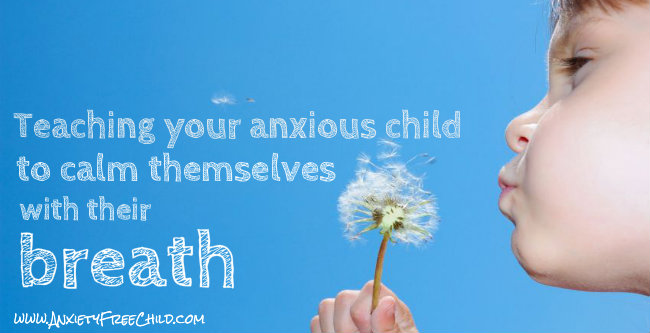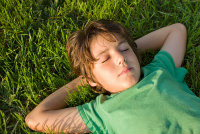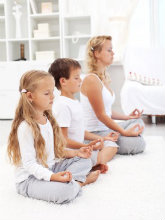 Newborns do it automatically. Musicians have done it to take the edge off the anxiety of their performance. Yogis make it a regular way of life. And your anxious kids can do it to calm themselves down, stave off a panic attack and alleviate symptoms of stress.
Newborns do it automatically. Musicians have done it to take the edge off the anxiety of their performance. Yogis make it a regular way of life. And your anxious kids can do it to calm themselves down, stave off a panic attack and alleviate symptoms of stress.
The “it” in this case is diaphragmatic breathing and, although it may sound like a strange concept, it is actually the way nature intended us to breathe. You’ll be amazed at what it can do for your anxious child.
What is Diaphragmatic Breathing?
You may not have heard of diaphragmatic breathing, but surely you’ve heard of “belly breathing”. The two are the very same thing. This pattern of breathing fully uses your diaphragm, or that handy muscle that sits below your lungs and helps move air in and out as you inhale and exhale.
Belly breathing involves full, languid breaths where you deeply exhale and inhale to receive the full extent of oxygen our bodies need. Although newborns automatically engage in diaphragmatic breathing, by the time most people hit 10 years old, they have already lost the habit.
Most instead make a habit of thoracic breathing, according to a report by Rebecca Kajander and Erik Peper published in Biofeedback. Thoracic breathing is that shallow, ineffective breathing pattern that uses upper chest muscles and largely ignores the diaphragm. To contrast how much different the two breathing patterns are, the report out thoracic breathing typically occurs at a rate of 15 to 22 breaths per minute. Diaphragmatic breathing, on the other hand, has a standard rate of 5 to 8 breaths per minute.
Yeah, wow is right. The slow, rhythmic nature of diaphragmatic breathing requires far fewer breaths per minute because you are taking far deeper breaths that more fully supply your body with the oxygen it needs. The rapid, shallow pattern of thoracic breathing can result in increased anxiety and panic as well as headaches, fatigue, cramps, irritability and muscle tension in the chest area.
To spot-check you and your anxious child’s own breathing patterns, place your palm on your stomach as you breathe as you normally would. Thoracic breathing will show little to no movement in your abdominal area while diaphragmatic breathing will show definite movement in the area. The latter fully moves your diaphragm muscle down with every inhalation and up with every exhalation, moving your belly in the process.
In addition to thoracic breathing, you or your anxious kid may suffer from a flurry of other bad breathing habits. They include holding his or her breath, sighing while breathing, gasping and reverse breathing. The latter occurs when an inhalation causes the stomach to deflate, rather than expand, and an exhalation causes the stomach to expand rather than deflate. Helping your child control the symptoms of their anxiety or panic with their breath is such a critical skill that we provide lots of simple to use techniques in the material we offer so your child can start benefitting as quickly as possible.
How and Why Diaphragmatic Breathing Helps
 Once you and your anxious children deepen and lengthen your breathing patterns, the first result you may note is simply feeling better. Making a habit of diaphragmatic breathing can wipe out the headaches, irritability and upper chest muscle tension, provide you with more energy and restore your body to a balanced state. Getting adequate oxygen also helps reduce panic and anxiety.
Once you and your anxious children deepen and lengthen your breathing patterns, the first result you may note is simply feeling better. Making a habit of diaphragmatic breathing can wipe out the headaches, irritability and upper chest muscle tension, provide you with more energy and restore your body to a balanced state. Getting adequate oxygen also helps reduce panic and anxiety.
“…When you don’t get enough oxygen, the brain receives a ‘danger’ signal, which perpetuates your mind-body state of anxiety,” Yoga Journal quotes Jonathan Davidson, director of Duke University Medical Center’s Anxiety and Traumatic Stress Program. “Your breathing quickens and becomes even more shallow; in an extreme case this can lead to a full-blown panic attack, in which the person begins to hyperventilate.”
In addition to giving your body adequate amounts of oxygen, diaphragmatic breathing helps maintain a steady level of carbon dioxide. Low levels of CO2 can result in hyperventilation, or a breathing pattern that involves extremely rapid or extremely deep breaths which supply your body with an overload of oxygen and CO2.
You or your anxious child may have hyperventilated when you were stressed out or fearful, in which case it typically passes quickly. Anxious children and adults can also suffer from chronic hyperventilation, which can cause everything from dizziness to digestive issues, poor concentration to a rapid or irregular heart rate. Diaphragmatic breathing keeps that nasty hyperventilation at bay.
Your anxiety can also decrease due to diaphragmatic breathing’s ability to restore sinus arrhythmia, Pacific Standard says. Sinus arrhythmia is a phenomenon where your heart rate goes up when you inhale and goes down when you exhale. The decrease in your heart rate with prolonged exhalation further kicks out feelings of panic and anxiety.
Supporting Research
A study published in the Journal of Consulting and Clinical Psychology examined the effects of a normalized breathing pattern for those suffering from panic disorder. The study specifically used a treatment program known as Capnometry-Assisted Respiratory Training, or CART, which employs breathing exercises while measuring CO2 levels. Subjects employed CART exercises twice each day, learning not to take the deep breaths that can exacerbate hyperventilation.
“Most panic-disorder patients report they are terrified of physical symptoms such as shortness of breath or dizziness,” said Alicia Meuret, researcher and Southern Methodist University panic disorder expert. “In our study, cognitive therapy didn’t change respiratory physiology, but CART did effectively reduce hyperventilation. CART was proved an effective and powerful treatment that reduces the panic by means of normalizing respiratory physiology.”
Another study, this one appearing in the online journal PLOS One, checked out breathing’s effects on musicians and singers. A group of 35 orchestra musicians and 11 singers were asked to rate their base anxiety levels and then were hooked up to a machine that measured their heart rates. They were given a difficult classical music passage to perform after five minutes of preparation.
After their initial performance, they were divided into three groups. One group practiced a 30-minute deep, slow breathing exercise. Another group did the same with biofeedback. The third group was told to review the music and relax. All three groups then preformed the piece again. Those who practiced the breathing exercises showed a decreased level of stress than those who simply relaxed, with the same amount of relief found whether or not they engaged in biofeedback.
Alcoholics with anxiety disorders found relief through deep breathing in a study published in Biofeedback and Self Regulation. A portion of the study participants were told to slow down their breathing to 10 breaths per minute, much lower than the typical thoracic rate of 15 to 22 breaths per minute, while other participants were told to just relax on their own. Those who engaged in the breathing exercises reported feeling less anxious than those told to relax.
Another plug for diaphragmatic breathing comes from a study in the Journal of the American Medical Association. It illustrated how a slow, deep breathing pattern was actually as effective as the antidepressant imipramine for alleviating anxiety.
Additional research cited by Kajander and Peper hailed diaphragmatic breathing as helpful for health issues beyond panic and anxiety. They reported it can help treat asthma, pain, heart-related symptoms, high blood pressure, sleep issues and hot flashes caused by menopause. All these benefits are topped off with diaphragmatic breathing’s ability to enhance overall physical performance as well as endurance.
Yoga Journal quotes Swami Karunananda, a senior teacher at Virginia’s Yogaville who uses the breath as a tool to help people deal with the anxiety-related conditions of depression, anger and fear.
“The breath and mind go together,” Karunananda says. “If the breath is calm, steady, and even, so are we. If the breath is shallow, agitated, and arrhythmic, the mind won’t be able to concentrate.”
How to Teach Your Child to Breathe to Reduce Anxiety
 Teaching your anxious kid to use his or her breath to reduce anxiety starts by example. Kids naturally mimic what they see, and illustrating how you adapt your own breathing pattern to relax is a great place to start. You can expand on the lessons by engaging your anxious child in several exercises to help normalize and regulate her breath.
Teaching your anxious kid to use his or her breath to reduce anxiety starts by example. Kids naturally mimic what they see, and illustrating how you adapt your own breathing pattern to relax is a great place to start. You can expand on the lessons by engaging your anxious child in several exercises to help normalize and regulate her breath.
Belly Breathing 101
Capitalize on the term belly breathing with an exercise that makes kids take note of the movement of their bellies. Kajander and Peper offer detailed instructions:
- Have your child lie on the floor or sit with his back straight and feet supported.
- Your child should place on hand on his belly and the other on his chest.
- Tell your anxious child to imagine a balloon is in his belly. With each inhale, the balloon should fill up plump and fat, and with each exhale it should fully deflate.
- Have your kid breathe in through his nose, deeply pulling air into his lungs. He should feel his belly expand.
- Have your kid slowly breathe out through his mouth as his belly fully deflates. Enhance the exhalation by having him say “haa” as he expels his breath.
- Count the inhalations and exhalations, having your child inhale for 3 seconds and exhale for 6 seconds.
- Repeat for several minutes, ensuring your child keeps his shoulders relaxed, firm and square, without rising during each inhale.
Breathing in Unison
Practicing belly breathing side by side with your child can help immensely, as his breath will automatically begin to match your own. You can have your kid place his hands on your belly to get the full effect of what belly breathing means so he can better imitate it on his own.
Exhaling from the Feet
If your child is in the midst of a bout of severe anxiety and having trouble with diaphragmatic breathing, Kajander and Peper recommend another visualization tool. Tell your kids to imagine exhaling air not only from their bellies, but all the way down their legs and down to their feet. You can gently stroke your kid’s legs or arms while he’s exhaling to make the process even easier. The imagery also works to prompt kids to give each exhalation the full attention it deserves.
Diaphragmatic Breathing and Meditation
You and your anxious child can enhance the benefits of diaphragmatic breathing even further by coupling it with meditation. In its most basic form, meditation involves setting time aside with your anxious child where you do nothing else but focus on your breathing. Choose a quiet place devoid of distractions and sit comfortably on a chair or the floor. Set a timer for a specific length of time and spend that time with your eyes closed focusing on your breath.
You can delve more deeply into the concepts of mindfulness and meditation by getting started with the program we offer or by reading our mindfulness and meditation guide. You can also keep it simple and use the counting system mentioned earlier with 3 second inhalations and 6-second exhalations. Regardless of how you explore deep breathing with your anxious child, you both are sure to benefit for years to come.
SOURCES:
- http://www.sciencedaily.com/releases/2010/12/101220200010.htm
- http://biofeedbackhealth.files.wordpress.com/2011/01/1998-kajander-and-peper.pdf
- http://www.yogajournal.com/lifestyle/894
- http://specialchildren.about.com/od/mentalhealthissues/a/breathing.htm
- http://www.psmag.com/health/performance-anxiety-take-a-deep-breath-47882/





